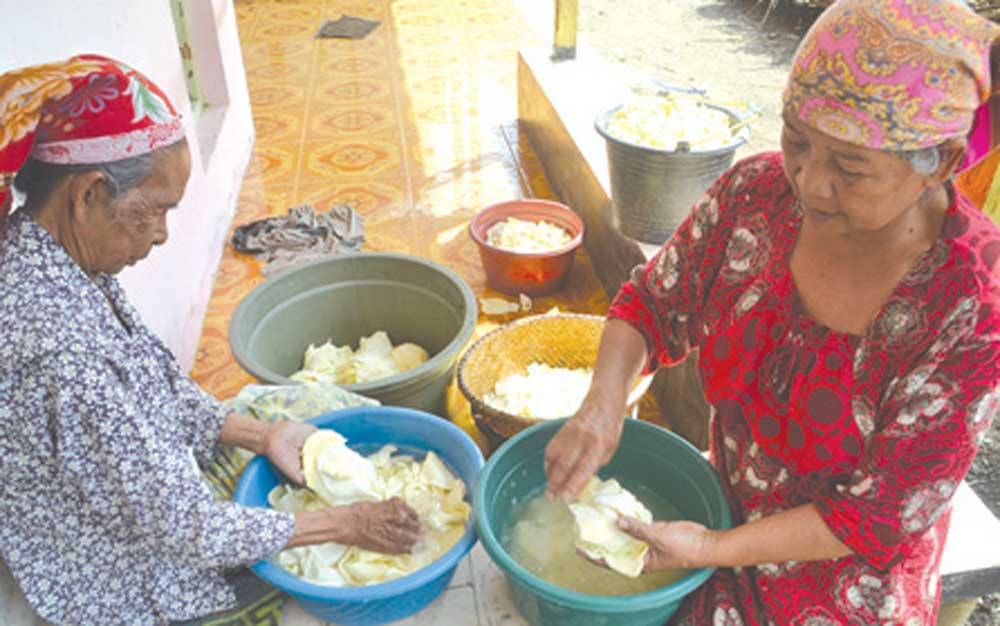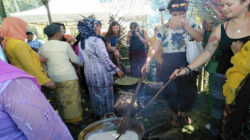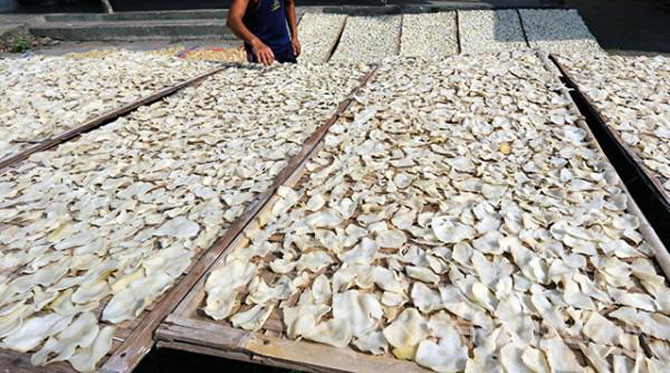RAMADAN menjadi bulan yang penuh berkah bagi warga Dusun Derwono, Desa Balak, Kecamatan Songgon. Sebagian besar masyarakat yang bekerja sebagai petani itu memproduksi keripik gadung demi menopang kebutuhan hidup menjelang Lebaran.
Sepanjang tepi jalan raya di Dusun Derwono pun penuh jemuran gadung atau sejenis umbi-umbian yang banyak tumbuh di kebun. Jemuran yang berwarna abu-abu itu menghampar di sepanjang tepi jalan raya. Tak jauh dari tempat penjemuran gadung itu, sejumlah ibu rumah tangga terlihat asyik ngobrol bersama rekan-rekannya.
Mereka tampak sibuk. Ada yang mengupas, mengiris, mencuci, dan ada juga yang berada di depan tungku api. Mereka itu adalah warga yang tengah mengolah dan memproduksi keripik gadung. Proses pengolahan gadung menjadi keripik tidaklah mudah, butuh ketelitian, kejelian, dan pengalaman.
“Salah sedikit saja dalam mengolahnya bisa berbahaya. Bisa mendem (mabuk akibat keracunan), kepala pusing dan perut mual,” ujar Rupiah, 65, salah seorang perajin keripik gadung. Umbi dengan nama latinnya dioscorea hispida itu memang tidak seperti umbi-umbian lain.
Selain bentuknya yang unik, umbi gadung juga hanya dipanen sekali dalam setahun. Daun dan batang tanaman tersebut hingga kini masih belum bisa dimanfaatkan untuk kebutuhan apa pun. Beda dengan umbi singkong, daunnya dimanfaatkan sebagai sayur.
Umbi gadung memang banyak tumbuh di kebun milik warga. Sebab itulah, warga memilih memanfaatkan tanaman tersebut menjadi produk olahan pangan berupa keripik. “Hanya bisa diolah keripik, lainnya masih belum bisa,” terang nenek dua cucu itu.
Proses pengolahan gadung menjadi keripik itu diawali dengan dicuci bersih dan dikupas terlebih dahulu. Selanjutnya, umbi diiris tipis-tipis. Agar efisien dan tidak menyita waktu, warga mengiris menggunakan alat berupa papan kayu yang diberi pisau.
Hasilnya tipis dan lebih cepat. Setelah diiris, gadung yang masih mengeluarkan getah itu dinetralkan dengan cara ditaburi abu gosok dan garam. Jika tidak merata dan getahnya masih melekat, bisa berakibat fatal, yakni menyebabkan keracunan.
Oleh karena itu, pada tahap ini harus benar-benar teliti, sabar, dan tidak terburu-buru. Setelah permukaan gadung ditaburi abu gosok, dijemur dibawa terik matahari. Setelah benar-benar kering, irisan gadung itu diletakkan dalam karung dan direndam selama semalam untuk menghilangkan abu gosok dan getah yang masih menempel.
“Selama direndam, airnya harus mengalir. Tidak boleh menggenang,” katanya. Usai direndam, irisan gadung itu ditiriskan dan dikukus hingga benar-benar matang dan empuk. Tidak berhenti di situ, gadung masih harus dicuci lagi hingga bersih dan dijemur di bawah terik matahari hingga jadi seperti kerupuk.
Khusus penjemuran kali kedua dilakukan di daerah pesisir. “Kalau dijemur di dataran tinggi, anasnya kurang, jadi harus dibawa ke daerah pesisir yang panasnya menyengat,” jelas Rupi’ah. Proses membuat keripik gadung memang butuh waktu cukup lama.
Dari proses awal mengupas, mengiris, hingga menjemur kali kedua, minimal butuh waktu tiga hari tiga malam. Tidak terlalu berlebihan jika saat ini harga keripik gadung setengah jadi mencapai Rp 25 per kilogram (Kg). “Jualnya memang masih mentahkering,” ujar Endah, produsen keripik gadung lain.
Lantas, keripik gadung yang telah kering dalam kondisi setengah jadi dikemas dalam karung dengan berat 35 kg. Selama Ramadan ini bisa memproduksi hingga 35 kg dalam waktu tiga hari tiga malam. Keripik yang sudah jadi banyak dipesan toko dan konsumen dari berbagai daerah di Kabupaten Banyuwangi, seperti Kecamatan Rogojampi, Genteng, Singojuruh, Srono, Cluring, dan Muncar.
Dibandingkan tahun lalu, produksi keripik gadung tahun ini relatif menurun. Itu disebabkan umbi gadung sangat minim dan belum bisa dipanen lantaran masih terlalu muda. Makanya, harga keripik gadung kini lebih mahal dibanding Ramadan tahun lalu.
Meski beda tangan dan beda orang yang membuat, jika digoreng rasa keripik gadung made in Derwono, Balak, hampir sama dan sangat beda dengan keripik dari luar dusun. Bagi warga Dusun Derwono membuat keripik gadung sudah menjadi tradisi setiap Ramadan. Karena sudah menjadi tradisi, Dusun Derwono mendapat julukan Kampung Keripik Gadung.
“Keripik gadung asal Derwono memang terkenal ke seluruh Banyuwangi. Di pasar saja orang mau beli kerap bertanya terlebih dulu kepada pedagang. Jika tidak keripik Derwono kadang mereka tidak jadi beli, karena rasanya beda,” tandas Kepala Desa Balak, Ribut Santoso. (radar)








